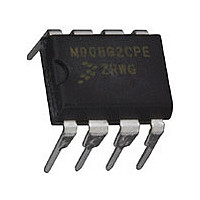MC68HC908QT2CPE Freescale, MC68HC908QT2CPE Datasheet - Page 81

MC68HC908QT2CPE
Manufacturer Part Number
MC68HC908QT2CPE
Description
Manufacturer
Freescale
Datasheet
1.MC68HC908QT2CPE.pdf
(184 pages)
Specifications of MC68HC908QT2CPE
Cpu Family
HC08
Device Core Size
8b
Frequency (max)
8MHz
Total Internal Ram Size
128Byte
# I/os (max)
6
Number Of Timers - General Purpose
2
Operating Supply Voltage (typ)
3.3/5V
Operating Supply Voltage (max)
5.5V
Operating Supply Voltage (min)
2.7V
On-chip Adc
4-chx8-bit
Instruction Set Architecture
CISC
Operating Temp Range
-40C to 85C
Operating Temperature Classification
Industrial
Mounting
Through Hole
Pin Count
8
Package Type
PDIP
Program Memory Type
Flash
Program Memory Size
1.5KB
Lead Free Status / RoHS Status
Compliant
- Current page: 81 of 184
- Download datasheet (2Mb)
If the MODEK bit is set, the keyboard interrupt inputs are both falling edge and low-level sensitive, and
both of the following actions must occur to clear a keyboard interrupt request:
The vector fetch or software clear and the return of all enabled keyboard interrupt pins to logic 1 may occur
in any order.
If the MODEK bit is clear, the keyboard interrupt pin is falling-edge sensitive only. With MODEK clear, a
vector fetch or software clear immediately clears the keyboard interrupt request.
Reset clears the keyboard interrupt request and the MODEK bit, clearing the interrupt request even if a
keyboard interrupt input stays at logic 0.
The keyboard flag bit (KEYF) in the keyboard status and control register can be used to see if a pending
interrupt exists. The KEYF bit is not affected by the keyboard interrupt mask bit (IMASKK) which makes
it useful in applications where polling is preferred.
Freescale Semiconductor
TO PULLUP ENABLE
KBI0
TO PULLUP ENABLE
KBI5
•
•
AWUIREQ
Vector fetch or software clear — A vector fetch generates an interrupt acknowledge signal to clear
the interrupt request. Software may generate the interrupt acknowledge signal by writing a 1 to the
ACKK bit in the keyboard status and control register (KBSCR). The ACKK bit is useful in
applications that poll the keyboard interrupt inputs and require software to clear the keyboard
interrupt request. Writing to the ACKK bit prior to leaving an interrupt service routine can also
prevent spurious interrupts due to noise. Setting ACKK does not affect subsequent transitions on
the keyboard interrupt inputs. A falling edge that occurs after writing to the ACKK bit latches
another interrupt request. If the keyboard interrupt mask bit, IMASKK, is clear, the central
processor unit (CPU) loads the program counter with the vector address at locations $FFE0 and
$FFE1.
Return of all enabled keyboard interrupt inputs to logic 1 — As long as any enabled keyboard
interrupt pin is at logic 0, the keyboard interrupt remains set. The auto wakeup interrupt input,
AWUIREQ, will be cleared only by writing to ACKK bit in KBSCR or reset.
KBIE0
KBIE5
(1)
.
.
.
Figure 9-2. Keyboard Interrupt Block Diagram
1. For AWUGEN logic refer to
MC68HC908QY/QT Family Data Sheet, Rev. 6
MODEK
V
DD
D
CK
CLR
Q
INTERRUPT FF
Figure 4-1. Auto Wakeup Interrupt Request Generation
KEYBOARD
RESET
ACKK
IMASKK
SYNCHRONIZER
VECTOR FETCH
INTERNAL BUS
DECODER
KEYF
Functional Description
Logic.
KEYBOARD
INTERRUPT
REQUEST
81
Related parts for MC68HC908QT2CPE
Image
Part Number
Description
Manufacturer
Datasheet
Request
R

Part Number:
Description:
TOWER ELEVATOR BOARDS HARDWARE
Manufacturer:
Freescale Semiconductor
Datasheet:

Part Number:
Description:
TOWER SERIAL I/O HARDWARE
Manufacturer:
Freescale Semiconductor
Datasheet:

Part Number:
Description:
LCD MODULE FOR TWR SYSTEM
Manufacturer:
Freescale Semiconductor
Datasheet:

Part Number:
Description:
DAUGHTER LCD WVGA I.MX51
Manufacturer:
Freescale Semiconductor
Datasheet:

Part Number:
Description:
TOWER SYSTEM BOARD MPC5125
Manufacturer:
Freescale Semiconductor
Datasheet:

Part Number:
Description:
KIT EVALUATION I.MX51
Manufacturer:
Freescale Semiconductor
Datasheet:

Part Number:
Description:
KIT DEVELOPMENT WINCE IMX25
Manufacturer:
Freescale Semiconductor
Datasheet:

Part Number:
Description:
TOWER SYSTEM KIT MPC5125
Manufacturer:
Freescale Semiconductor
Datasheet:

Part Number:
Description:
TOWER SYSTEM BOARD K40X256
Manufacturer:
Freescale Semiconductor
Datasheet:

Part Number:
Description:
TOWER SYSTEM KIT K40X256
Manufacturer:
Freescale Semiconductor
Datasheet:

Part Number:
Description:
Microcontrollers (MCU) MX28 PLATFORM DEV KIT
Manufacturer:
Freescale Semiconductor
Datasheet:

Part Number:
Description:
MCU, MPU & DSP Development Tools IAR KickStart Kit for Kinetis K60
Manufacturer:
Freescale Semiconductor
Datasheet:

Part Number:
Description:
24BIT HDMI MX535/08
Manufacturer:
Freescale Semiconductor
Datasheet:
Part Number:
Description:
Manufacturer:
Freescale Semiconductor, Inc
Datasheet:
Part Number:
Description:
Manufacturer:
Freescale Semiconductor, Inc
Datasheet:










